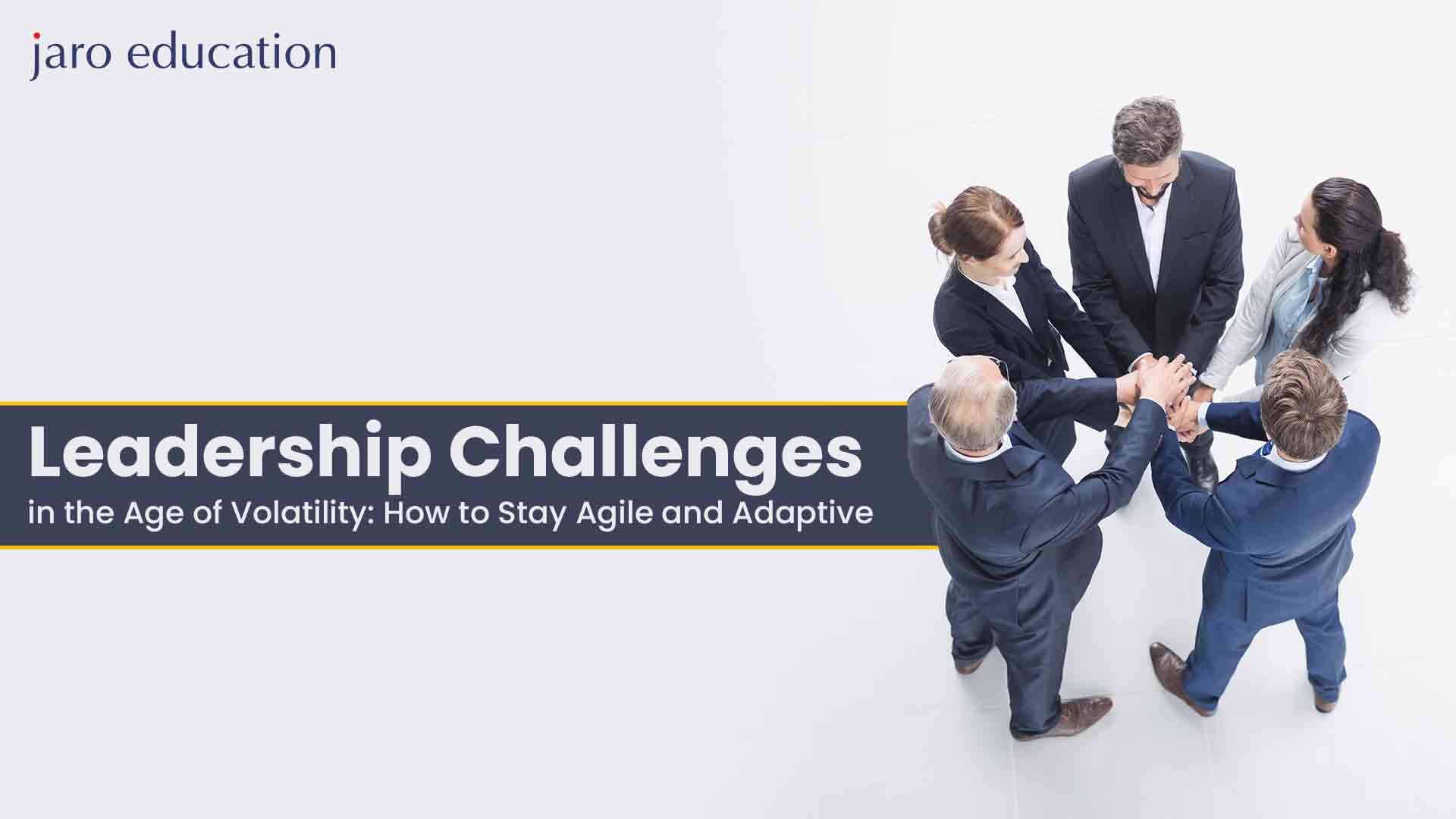Leadership Challenges in the Age of Volatility:
How to Stay Agile and Adaptive
Table of Contents

- jaro education
- 14, December 2023
- 10:40 am
In the dynamic landscape of the contemporary world, marked by rapid technological advancements, geopolitical shifts, and unprecedented global challenges, leadership faces a myriad of complex hurdles. The Age of Volatility has ushered in an era where traditional leadership paradigms are continually tested and reshaped.
This blog is dedicated to unravelling the complex tapestry of leadership challenges that come hand-in-hand with such a dynamic environment, dissecting these leadership challenges and understanding their intricacies. As we delve into the core of agile and adaptive leadership, we aim to equip current and aspiring leaders with the tools and insights needed to turn volatility into a landscape rife with opportunity.
Understanding Leadership Challenges in Volatile Times
In today’s context, leadership challenges are multifaceted and deeply influenced by the unpredictable nature of global markets and rapid technological evolution. Leaders are finding that their tried-and-true strategies and models are quickly becoming outdated in the face of emergent, disruptive forces. This volatility complicates decision-making and strategic planning, placing immense pressure on leaders to forecast and plan for an array of potential futures.
The speed of technological advancements presents both opportunities and threats, demanding that leaders stay informed and ready to leverage new tools while guarding against obsolescence. Moreover, market conditions fluctuate with increasing speed, often driven by geopolitical tensions, economic shifts, and social change, all of which demand a leader’s constant attention and agility.

Agile Leadership as a Response to Volatility
Agile leadership is the answer to this high-velocity, high-uncertainty environment. It embodies the ability to remain flexible, to think on one’s feet, and to pivot quickly in response to new information. Agile leaders are proactive, anticipating change rather than waiting to react to it. They understand that foresight can mitigate the risks associated with volatility.
To cultivate agility within their teams, leaders must promote a culture of openness and continuous learning. They must encourage experimentation and accept that failure is a part of the innovation process. Agile leaders also understand the importance of decentralized decision-making, allowing team members closest to the problem to propose and implement solutions quickly.
Navigating Leadership Issues with Adaptability
Adapting to change is a significant leadership issue, often compounded by the human resistance to alter familiar patterns. Leaders must be adept at managing not just the operational aspects of change but also its psychological impact. Emotional intelligence becomes a critical skill in these situations, enabling leaders to understand and address the concerns and resistance that may arise from their teams.
This involves providing training, resources, and, perhaps most importantly, patience. Leaders should set an example by adapting their behavior and attitudes to champion the change they wish to see within their organization.
In navigating these leadership challenges and leadership issues, the thread that connects agility and adaptability is the ability to maintain a clear vision of the organization’s core values and goals. It is this vision that guides leaders and their teams through the volatility of our times, ensuring that despite the rapid changes in the external environment, the course towards long-term success remains true.
For those navigating the complex landscape of leadership, where change is constant and adaptability is paramount, the “Corporate and Public Leadership in a VUCA World” by IIM Indore, offer a strategic pathway. Embark on this enriching journey today to equip yourself with the skills necessary for success in the dynamic and unpredictable world of business.
The Adaptive Leader's Toolkit
In the face of volatility, leaders need resilience to navigate through adversity, a clear vision for guidance, and excellent communication to maintain team alignment. Lifelong learning and adaptability are essential, as they ensure relevance and preparedness for emerging challenges. Additionally, leveraging data analytics is critical for making informed decisions and staying ahead of industry trends.
Communication and Collaboration in Agile Leadership
Effective communication is vital in agile leadership, especially when guiding teams through change. In remote or hybrid setups, this involves using digital tools for collaboration and ensuring all voices are heard. A leader’s ability to articulate a clear direction and foster a sense of community is paramount in maintaining team unity and momentum.
Overcoming Resistance to Change
Addressing resistance to change requires understanding the underlying psychological barriers and empathetically engaging with the team’s concerns. Involving team members in the change process and clearly explaining the benefits helps reduce resistance. Providing the necessary support facilitates smoother transitions, turning these leadership challenges into opportunities for growth.
Case Studies: Leadership Success Stories
The turbulent business landscape is rife with stories of leaders who have turned volatility into victory. These narratives provide practical blueprints for success and demonstrate the power of agility and adaptability in leadership.
One such example is that Atlassian’s leadership has been exemplary in fostering a people-first culture. Archana Rao, CIO at Atlassian, emphasizes the importance of teamwork over individual accolades, stating that “Success is 100% based on my team. Without my team, I can’t accomplish anything.” This team-centric approach is echoed by Helen Russell, Atlassian’s Chief People Officer, who notes that the most successful leaders speak in terms of ‘we’ rather than ‘I’.
Robert Chatwani, CMO at Atlassian, follows the principles of servant leadership, striving to be what Jim Collins describes as a Level 5 Leader in his book “Good to Great.” He focuses on empowering individuals to reach their full potential, facilitating their growth for a larger impact on the organization. Chatwani’s leadership style involves engaging with team members at all levels, sharing strategic insights, and maintaining open lines of communication.
The Path Forward: Sustaining Agility and Adaptability
To stay ahead of the curve, leaders must embrace an ethos of perpetual evolution, fostering not just a culture of agility and adaptability within their teams but also within themselves. This involves continuous scanning of the horizon for emerging trends and technologies, and cultivating a willingness to pivot strategies as needed.
Thus, the development of agile and adaptive leadership is an ongoing journey. It requires a commitment to self-improvement, a learning mindset, and an organizational culture that values and supports flexibility. By embedding these principles into the DNA of their operations, leaders can future-proof their organizations, ensuring they are resilient and can turn challenges into opportunities for growth.
Conclusion
In closing, the dynamism of our times does not just require leaders to be agile and adaptable; it demands it. As we’ve explored, the relentless pace of change presents both challenges and opportunities, and it is the leaders who can pivot with grace and strategy who will lead their organizations to thrive. Take action on the strategies outlined: build resilience, foster a culture of continuous learning, and leverage data to make informed decisions. Remember, the journey of leadership is one of constant evolution.
If in case, you are in search of an online program that can help you advance your leadership skills, then IIM Indore’s “Corporate and Public Leadership in a VUCA World” is a perfect fit for you. This program is designed to equip leaders with essential skills for thriving in an environment characterised by Volatility, Uncertainty, Complexity, and Ambiguity (VUCA) and underscores the necessity for leaders to have a blend of strategic foresight, resilience, effective complexity handling, and nimble decision-making capabilities to navigate today’s rapidly changing and unpredictable landscape.
Let this be a call to action—not just to navigate the present but to actively shape the future. Continually evolve, learn, and grow, for the path of leadership is perennially under construction.







